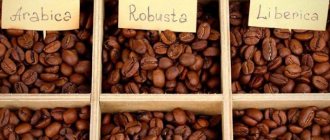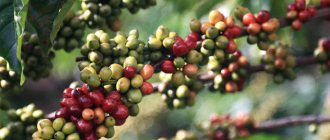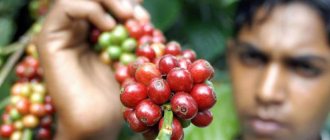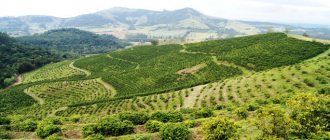Ethiopia is considered to be the birthplace of coffee. However, the people of Yemen were the first to cultivate and grow this plant. There is still debate about whether the first Yemeni coffee plantations first appeared in the 12th or 14th century.
Yemeni coffee is rare and therefore very expensive, but the cost is justified by its high quality. He is still considered one of the best in the world.
Mokhtar Alkhanshali
Modern Yemeni coffee owes a lot to Mokhtar Alkhanshali, who, despite the difficult political and economic situation in the country, managed to export invigorating beans to Europe and the USA. Mokhtar went into the fields with local farmers, taught them modern technologies seen in the West, and worked to improve the quality of coffee in Yemen. In 2015, he risked his life to escape the war-torn country to bring samples of the latest harvest to a coffee conference in Seattle. Coffee from Yemen instantly made a splash, scoring the highest number of points in blind testing.
Mokhtar was born in the United States to Yemeni immigrants. The young man’s ancestors were engaged in growing coffee, and in 2013 the young man decided to revive the family tradition. To achieve this, Mokhtar tirelessly shuttled between Yemen and the United States, establishing trade ties. The entrepreneur was helped by the fact that he spoke the Yemeni language and also shared the culture and traditions of local farmers. On the other hand, in the USA he learned advanced technologies, knew how to cultivate grain and conduct business more efficiently.
Mokhtar Alkhanshali
Now, due to difficulties with transportation and the use of virtually exclusively manual labor, the price of a cup of Port of Mokha brand coffee supplied by Mokhtar can reach up to $16. Thanks to this, farmers in Yemen earn 6-12 times more than their counterparts in neighboring Ethiopia.
Plantations that are five thousand years old
Several hundred years ago, coffee trees in Yemen began to be grown purposefully for the first time to produce a harvest of aromatic beans. For a long time, this country remained a monopolist in the trade of coffee beans. However, the cunning of competitors who craved coffee super-profits quickly deprived the country of its leading position.
The fact is that the climate and terrain of Yemen do not allow growing large crops. Some coffee plantings are just a few trees that miraculously stay on the mountain slopes. Constant problems with land reclamation, as well as a decrease in the total area of agricultural land, also reduce productivity. So, even on the previous scale, there is simply nowhere to grow coffee.
Yemen occupies a modest position in the fifth ten world coffee suppliers. About 7-8 thousand tons of coffee per year are supplied to the foreign market. The entire crop is organically grown Arabica. Many trees grow in the same places that were cultivated five or six hundred years ago. Older than them in age are probably only the natural coffee plantations of Ethiopia.
Yemeni farmers have preserved ancient technologies for growing and processing grains. They do not use chemical fertilizers, preferring to follow the same techniques that they inherited from their ancestors. The coffee beans are collected, dried on the flat roofs of houses, cleaned and winnowed. All operations are performed manually, usually by members of the same family. The only improvement that Yemenis allow themselves is greenhouses for growing seedlings and young seedlings.
Due to the fact that harvests are small, coffee beans from Yemen are quite expensive. Instant drinks are not produced from them. Even substandard, broken grains are sold, and at a very impressive price.
Why is Yemeni coffee so popular?
It's all about the special composition of the soils of this country. Typically, coffee in South America and Africa is grown on volcanic soils that are highly acidic. This greatly affects the flavor of the beans, giving them an obvious sourness. The composition of the soil on which the coffee tree grows determines the taste of the finished drink. For example, many Brazilian varieties have a strong medicinal smell due to their high quinine content, and some Guatemalan varieties have a spicy, smoky note due to the large amount of volcanic ash in the soil.
Coffee from Yemen has a pleasant, dense taste, practically devoid of acid. The drink is decorated with fruit and wine notes, which make the taste especially rich and varied. The depth of taste sensations is noted by everyone who has tried the drink. Dark color, persistent and strong aroma - these are the signs of real coffee from Yemen, for which it is highly valued.
Mocha
In modern interpretation, the term “mocha” means a mixture of coffee with hot chocolate or espresso with chocolate syrup. In fact, this is a unique variety of Yemeni coffee, named after the port city through which aromatic beans were transported to other countries.
Mocha coffee belongs to the Arabica class and is cultivated in the vicinity of the capital, Sana'a. Another name for the variety is Yemeni Udaini, it has a natural chocolate flavor, a price reaching up to $240 per pound and is considered one of the best coffees in the world.
Yemeni mocha
Adding to the confusion is Ethiopian Harrar coffee, which is also often marketed under the name “mocha” or “moka”. Despite the fact that the varieties are indeed similar, the Ethiopian counterpart is lighter in body.
Coffee traditions of Yemen
The Yemenis themselves treat coffee with great respect; certain rituals, traditions and customs are associated with the drink.
For example, every family has its own secret of making coffee, which is never told to anyone. If you are invited to lunch and are treated to coffee, then it is simply unthinkable to refuse. This amounts to a grave insult to the owners of the house, because drinking a drink together is a gesture of trust and friendship.
Yemen consumes about 30% of the coffee grown, despite the fact that many residents of the country prefer to taste coffee in its, so to speak, original form, or rather, recipe. After all, initially the drink was not prepared from grains at all. On the contrary, they were considered unsuitable and were simply thrown away. A strong infusion was made from the coffee berries themselves, dried and freed from grains. This recipe, with added spices, is still very popular in Yemen.
A recipe for coffee with caramel and ginger is in demand. Sugar is heated in a Turk, a whisper of fresh, finely chopped ginger root is added, then freshly ground coffee and poured with water. Bring until the foam rises, then filter through a sieve.
So, if you suddenly want to add something exotic to the peaceful course of your working day, get coffee from Yemen and brew a drink according to this recipe. Close your eyes and imagine a distant country where, for over 500 years, they have been growing excellent grains that we can enjoy even in our harsh northern climate. Let the aroma of coffee plantations ripening under the southern sun fill your home, making the world around you a little more diverse.
Characteristics of coffee from Yemen
Yemeni coffee has a rich bouquet with notes of tropical fruits, flowers and spices. There are varieties with earthy, woody and tobacco accents.
Types of Yemeni coffee:
- Udaini (Mocha);
- Dawairi;
- Tufahi;
- Bura'ai;
- Abu Sura.
In addition, there are literally hundreds of local names used in the home market, sometimes with dozens of designations for a single variety, and whether they refer to a bean type or region of origin can never be said with certainty. The beans are processed using the dry (or “natural”) method, when the coffee cherries are first dried in the sun (often right on the roofs of houses), and only then peeled from the pulp and skin.
The country's coffee industry is represented by small farms, most of the plantations are located on mountain terraces. Local grains tolerate drought well and produce abundant harvests even in hot climates.
Famous brands of Yemeni coffee: Volcanica, Port of Mokha, Sweet Maria's.
Cooking methods
To prepare real Yemeni coffee, you first need to fry the fruits along with the shell on a baking sheet, and then grind them in a mortar. The resulting powder is placed in a pot of water and brought to a boil twice. When performing these steps, you will be able to get a thick and strong drink. Ginger, salt and cloves are added to it.
You can make Yemeni coffee at home using the following recipe. The following ingredients are needed:
- 2 teaspoons of ground grains;
- a pinch of chopped ginger root;
- 2 teaspoons sugar;
- 120 ml water.
Preparation comes down to the following steps:
- Place all the products in a pot and pour water into it.
- Heat the liquid until foam appears and immediately after that remove the cezve from the stove.
- Strain the prepared drink.
Incredibly tasty and aromatic coffee is grown in Yemen. The peculiarity of this country’s coffee products is the use of ancient technologies and manual processing of beans. In addition, no chemicals are used when growing fruits. These factors are often decisive when choosing.
Regions
- Bani Mattar. The local coffee is called Mattari, grows at an altitude of about 1400 meters, has a distinct sourness, wine notes and a complex fruity aroma.
- Hiraazi. The coffee is similar to Mattari, but lighter in body.
- Ismaili. Delicate and soft coffee with a berry flavor is produced here.
- Sanani. Coffee of lower quality compared to other regions is characterized by a medium body, a balanced profile, and a fruity taste with almost no sourness.
Mocha is a bean variety that can be cultivated in any region. Mocha Mattari is considered the most delicious.
Tree growing conditions
Yemeni coffee is an old variety of Arabica - Typica, which has adapted to volcanic soils. They have high acidity, so the grains also taste sour. The rich mineral composition of the soil allows you to grow grains without additional fertilizing and means to combat diseases and pests. Yemen is the only country where no agrochemicals are used at all.
The climate in Yemen is hot, but the trees have adapted well to local conditions and produce a stable harvest. The plantations are located on the so-called mountain terraces - steps in the form of steps rising up the slope. To protect plants from the scorching sun, coffee trees are planted under fruit palms.
The country has problems with water, and local “entrepreneurs” have begun to grow the khat plant, which is used to make a narcotic drug. It requires a lot of water. However, khat plantings are 7 times larger than the area of coffee plantations.
The most delicious grains are considered to be those growing at an altitude of more than 1400 m above sea level. With a lack of oxygen, the grains linger longer on the branches, the ripening period is prolonged and the berries gain a full range of flavors.
Trees located lower are lighter in weight and have a limited flavor palette.
Popular varieties
The most expensive variety is Yemen Mocha. Arabica beans are elongated and orange in color, most likely due to minerals in the soil. The variety goes on sale as part of blends, since its yield is not high.
Popular blends:
- Yemen Matari has a bright chocolate taste after roasting. It is better to drink it in its pure form to appreciate all the shades of taste.
- Hodeidah is a blend of several varieties of local Arabica, which are also grown in limited quantities and are not sold separately. In addition to chocolate, the flavor range of Hodeidah is complemented by wine and citrus notes.
- Sanani is a composite variety grown near a city called Sana. This is a less expensive variety with a light aroma.
- Hiraazi is a less aromatic variety than Mocha. It goes on sale as a blend.
- Izmaili is a variety with the same name as the region and has a berry flavor.
Companies in Russia that purchase raw materials, package them and sell them are called Rokka and Amado.
There is a local company Blues, which is engaged in roasting and packaging of products, as well as the Turkish Osman - it purchases raw materials cheaper.
In terms of cost, the most expensive product is Yemeni. The price of 500 g is about 3 thousand rubles. It is processed using the old dry method, drying the grains on the roofs of houses. This method has not undergone any changes over the entire 600-year history of plantation cultivation.











